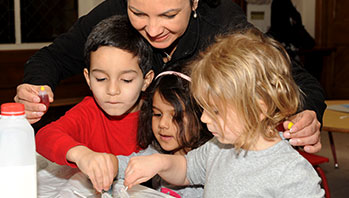- camera
- dark paper or cloth
- food for the worms (leaves and grass clippings)
- large glass container with a screen cover or a clear plastic or glass jar and lid with holes
- large plastic spoons
- magnifying lenses
- soil (dry and moist)
- spray bottle filled with water
- worms
- environment
- habitat
- plant
- soil
- underground
- worm
MA Standards:
English Language Arts/Language/L.PK.MA.6: Use words and phrases acquired through conversations, listening to books read aloud, activities, and play.
MA Draft Standards:
Life Sciences/Ecosystems; Biological Evolution/LS2/4.B: Using their experiences in the local environment and other evidence, raise and discuss questions about the basic needs of familiar organisms and how they might meet their needs. (Clarification statement: basic needs include water, food, air, shelter, and light for most plants)
Head Start Outcomes:
Social Emotional Development/Self-Regulation: Follows simple rules, routines, and directions.
Logic and Reasoning/Reasoning and Problem Solving: Classifies, compares, and contrasts objects, events, and experiences.
Science Knowledge/Conceptual Knowledge of Natural and Physical Worlds: Observes, describes, and discusses living things and natural processes.
PreK Learning Guidelines:
Science and Technology/Inquiry Skills 4: Record observations and share ideas through simple forms of representation such as drawings.
Science and Technology/Life Sciences 10: Observe and identify the characteristics and needs of living things: humans, animals, and plants.
Science and Technology/Living Things and Their Environment 17: Observe and describe how natural habitats provide for the basic needs of plants and animals with respect to shelter, food, water, air, and light.
Small Group: Create an Underground Environment

© Commonwealth of Massachusetts, Department of Early Education and Care (Jennifer Waddell photographer). All rights reserved.
STEM Key Concepts: Plants get their needs met from the environment (their habitat); Some plant parts are below the ground and some above; Earthworms are animals that live in the soil, underground
ELA Focus Skills: Listening and Speaking, Vocabulary
Educator Prep: Prior to the activity you will need to get some worms: you can dig up worms, purchase them from a bait shop, or order them from a biological supply catalogue.
Safety Tips:
- Be aware of and check for poison ivy and poison sumac before gathering children in a designated area.
- Remind children to wash their hands before and after the activity.
- Remind children not to eat ANY plants or touch any plants without asking an adult.
- Take children’s allergies into account before going outside.
Tell children that they are going to set up a habitat, or environment for worms, so they can observe the worms during the week. Explain that worms are one of the animals that help plants meet their needs. Ask questions to help children think of what they might need to do to build a worm habitat. Ask, Where do worms live? Remind children of their outdoor observations and say,
- What do you think we need to include in the environment? At this point, you may want to introduce a nonfiction book as a reference or go online to find information about how to set up a worm habitat with children.
Then guide children by asking questions such as,
- What is different about the two types of soil? (damp/dry) Which one do you think would be better for worms and plants? Why do you think that? (helps keep the worms’ skin wet; so roots can have water to bring to plants)
- Why do you think you need to put leaves and grass in the container with the worms? (food for worms)
Use the information you found online or in a nonfiction book and set up the environment with children in an area where children can visit and observe over the next few weeks.
Make a sequenced chart that shows each step you took in setting up the worm habitat. Hang it in the worm habitat area. Encourage children to draw a picture of the habitat in their science notebooks.
Social Emotional Tip: Help children build skills that help them initiate, organize, and participate in independent activities by discussing future plans with them.
Educator Tip: Be aware of children who show a dislike for worms. Do not force them to touch the worms, but encourage them to take part in other parts of the activity.
Educator Tip: You may wish to assign children to add grass and leaves and moisten the soil when necessary while the worm habitat is in the room.
Adaptation: For groups with children with tactile sensitivities, you may want to have large spoons on hand so those children can join in the activity comfortably.
